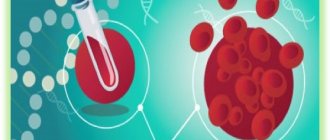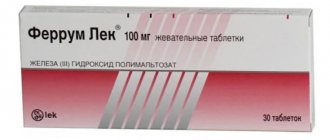Meanwhile, almost every seventh inhabitant of the Earth is a carrier of a “defective” gene that disrupts iron metabolism in the body, which ultimately leads to hemochromatosis (excessive levels of this trace element).
Fortunately, the “bad” gene is not triggered very often. But if it “works”, it won’t seem like much.
The floor goes to one of the leading experts in this field, gastroenterologist, candidate of medical sciences Svetlana Polyakova .
Causes
Iron, which comes from food, is absorbed in the gastrointestinal tract and settles in certain human organ systems, be it the liver or joints.
The reason for this process may be either the action of a gene that provokes increased absorption of iron, or long-term excessive intake of this element into the body along with chemicals or blood transfusions. Degradation of organs affected by excess iron does not occur immediately, but over time the symptoms only progress.
Hidden threat
Hemochromatosis is an insidious disease. For the time being, the disease shows almost nothing about itself. The bitter truth is revealed, as a rule, too late - by the age of 40, when the signs of hemochromatosis are obvious (from severe cirrhosis of the liver to diabetes and life-threatening arrhythmogenic cardiopathy), and it is almost impossible to do anything to save the patient. Unless a donor liver or heart is transplanted.
Article on the topic
Victims of iron deficiency risk anemia and anemia
Such consequences are caused by a congenital disorder of iron metabolism, as a result of which much more of this microelement is absorbed in the small intestine than the body requires. The result is sad: when deposited in the liver, pancreas, and heart muscle, excess iron causes lipid peroxidation, in response to which connective tissue begins to be actively produced in the affected organ, disrupting its structure, and therefore normal functioning.
Doctors can only shrug: if their predecessors had known about the presence of hemochromatosis in such a patient earlier, when he was a child or young adult, such problems could have been avoided.
Treatment
Hemochromacy does not occur on its own, but is provoked by certain risks that the patient should be aware of, be it heredity or frequent blood transfusions. If you notice the first symptoms, you should consult an endocrinologist, since delaying treatment leads to a worsening of the body’s condition.
During the treatment process, the endocrinologist prescribes a special diet to the patient, which excludes foods rich in iron from the diet, including apples, beets, buckwheat, red meat, red grapes, and pomegranates. Any alcoholic drinks are excluded; moreover, alcoholism itself causes hemochromatia.
Excess blood is treated through drug therapy prescribed by a doctor. Another effective way to combat this disease is periodic bloodletting, which also must be carried out under the close supervision of a doctor, as the level of hematocrit and hemoglobin in the blood should be monitored.
What you should know about increasing iron levels in the body
It is well known that iron is an essential element for all living organisms living in an oxygen environment. It is necessary for the transfer of oxygen (as part of hemoglobin) to all organs and tissues. Also, iron is part of the enzymes involved in “cellular respiration.”
The human body contains no more than 3-4 grams of iron and this amount is carefully maintained by regulating its absorption in the small intestine. The daily food requirement for this element is about 10 mg for men and 20 mg for women of childbearing age.
What factors affect iron levels?
Various factors influence iron levels in the body. The most important of which are: the amount of iron entering the body with food, taking medications containing iron, the fact of blood transfusion, the condition of the liver, the mucous membrane of the stomach and small intestine, the presence of blood loss, features of the menstrual cycle and hereditary causes.
If there is not enough iron in the body, iron deficiency anemia develops. But even more dangerous is the excess iron content, which accumulates excessively in the liver, spleen, and then in the skin, heart muscle, pancreas, thyroid and gonads, in the joints, which leads to an accelerated rate of “aging” and damage to these organs, growth in them connective tissue and disruption of their work. The risks of cirrhosis and liver cancer, diabetes mellitus, severe heart failure, and dysfunction of the thyroid and gonads increase.
The main reasons leading to oversaturation of the body with iron are genetic mutations, excessive intake of iron into the body from food (in red meat, wine, etc.), abuse of iron preparations (especially when administered intravenously), frequent blood transfusions, destruction (hemolysis ) red blood cells and chronic liver diseases.
Today, the high prevalence of iron oversaturation is known due to hereditary factors. This disease is called primary hemochromatosis, abnormal genes of which are detected in 1 in 250 residents of Northern Europe, and about the same number in Russia. Most often, this disease is detected in men over 40 years of age, less often in women after menopause.
Partially mutant genes for this disease may initially not manifest themselves in any way, but with the development of chronic liver damage, these genes are turned on, and the patient develops iron overload syndrome (IOS). Often, in approximately 20-30% of cases, this is observed with non-alcoholic and alcoholic fatty liver disease, viral hepatitis B and C.
How to suspect an oversaturation of the body with iron?
- If liver enlargement and/or changes in liver biochemical parameters are detected and their cause is not clear.
- If there is a chronic liver disease and, despite the treatment, “disturbed” biochemical parameters of the liver remain.
- If any examination reveals an increase in hemoglobin, iron, ferritin, transferrin in the blood.
- If you notice darkening of the skin on open areas of the body, hyperpigmentation and dry skin in the area of the armpits, groin folds, and old scars.
- If there are any combinations of diseases: liver cirrhosis, diabetes mellitus, joint damage, pathology of the heart and endocrine glands.
- If you have relatives suffering from hemochromatosis or PWS.
What to do if signs of iron oversaturation are detected?
If you identify signs of excess iron in the body, you should consult a doctor who specializes in the treatment of iron metabolism disorders, who will help you understand the cause of this condition, prescribe an examination plan, select the correct treatment and determine follow-up.
Methods for treating iron overload include: strict adherence to a diet limiting iron content to 8 mg/day, avoidance of alcohol, therapeutic bloodletting (phlebotomy), and the use of antioxidants.
Remember, iron accumulated in internal organs remains there forever! Therefore, timely detection and treatment of iron overload syndrome will prevent the occurrence and progression of damage to the liver and many other organs, the development of liver cancer and prolong your life.
GC Expert has developed a special program “Iron overload and hemochromatosis”, within which you can undergo an in-depth examination to determine the causes of iron overload and receive an individual treatment plan.
Prevention
Knowing that hemochromatia can occur due to prolonged blood transfusion, when carrying out this procedure, you should adhere to a diet that will reduce the entry of iron into the body. Reducing the amount of alcohol you drink also reduces the risk of excess iron in your body. If there is a risk of hemochromatia associated with heredity or certain circumstances, you should undergo preventive diagnostics by an endocrinologist approximately once every three months.
What is the danger of exceeding the norm?
The consequences of excess iron are very serious. An excess amount negatively affects the work:
- The liver is the filter of the whole body. If you notice the signs in a timely manner and begin treatment, the functioning of the vital organ will normalize. Otherwise, liver cells may be destroyed. This will lead to diseases: hepatitis and cirrhosis, necrosis, inflammation of the gallbladder.
- Kidneys. Excess trace elements are collected in the nephrons. They constantly poison the body. The filtration ability decreases, which provokes the occurrence of diabetes mellitus. Protective functions deteriorate, inflammatory processes develop.
- Impact on the nervous system. The brain suffers, the hypothalamus is overloaded. The head begins to hurt, thinking gradually slows down.
- Muscles. Excess iron causes fibers to break. Pain appears and muscle tone is lost. The heart is also a muscle. Poisoning it with iron can provoke the development of a micro-stroke or micro-infarction.
- Spleen. The main function of the organ is part of the metabolic processes occurring in the body, as well as the synthesis of iron. Gradually, iron is deposited on the walls of the organ, and inflammatory processes develop. They can penetrate nearby tissues.
Changes in nutrient balance during pregnancy are dangerous. Not only the expectant mother suffers, but also the child. From the mother's blood he receives all the substances he needs. Iron is an important component of hemoglobin. But in pregnant women, excess iron can provoke pathology of the placenta, to a greater extent the oxidation of free radicals, mitochondria in the placental cells die. Excess can cause gestational diabetes, which leads to miscarriage and subsequent development of infertility.
To prevent this from happening, blood tests are constantly taken from the expectant mother. Women should take medications containing Fe with caution and monitor the dosage.
It is more difficult to treat the consequences resulting from excess iron than from deficiency. Especially if the accumulation in the body has occurred for a long time, or it is a hereditary disease. But if the patient consults a specialist in time, when it is possible to avoid the bitter diagnosis of damage to internal organs, then the prognosis may turn out to be quite favorable.
Our clinics in St. Petersburg
Structural subdivision of Polikarpov Alley Polikarpov 6k2 Primorsky district
- Pionerskaya
- Specific
- Commandant's
Structural subdivision of Zhukov Marshal Zhukov Ave. 28k2 Kirovsky district
- Avtovo
- Avenue of Veterans
- Leninsky Prospekt
Structural subdivision Devyatkino Okhtinskaya alley 18 Vsevolozhsk district
- Devyatkino
- Civil Prospect
- Academic
For detailed information and to make an appointment, you can call +7 (812) 640-55-25
Make an appointment
Iron plays a very important role in the human body. It performs the function of oxygen transfer, takes part in oxidative processes, enzymatic reactions, providing immune functions, and cholesterol metabolism. In addition to red blood cells, iron is also found in brain cells.
Treatment regimen
- Deferoxamine. It binds to Fe and forms a water-soluble compound, ferrioxamine, which is excreted in the urine. She turns pink.
- Deferoxamine is given intravenously in the hospital if severe gastrointestinal symptoms, shock, or coma develop.
- Continuously given equivalent to 15 mg/kg/hour. The dose may be increased to a maximum of 35 mg/kg/hour depending on severity.
Typically, treatment lasts about 24 hours. Side effects may include hypotension and acute respiratory distress syndrome.
Symptoms and signs of high iron in the blood
Non-specific symptom - fatigue
A person with elevated levels of iron in the blood may not notice changes in health for a long time, if hyperferremia is not associated with serious diseases such as blood cancer or aplastic anemia.
Most often the patient notes:
- asthenia, fatigue, decreased performance, dizziness, memory impairment;
- nausea, intolerance to certain foods, often “heavy” foods - fatty, fried;
- weight loss;
- changes in the skin, which may acquire a bronze or yellowish tint, or dark pigment spots, become denser, rougher, and dryer;
- hair stiffness, sometimes crimping, then hair loss on the head and body, thickening of the nails;
- discomfort in the abdomen on the right and left with an enlarged liver and spleen.
Exhaustion may indicate advanced hyperferemia
More severe and later manifestations of the causes of hyperferremia are:
- bleeding at the slightest damage to the skin and mucous membranes, or spontaneous;
- extensive swelling;
- severe thinness, even cachexia;
- severe anemia despite high levels of iron in the blood.
Acute poisoning with injectable iron preparations manifests itself in the form of:
- sudden depression of the nervous system, seizures;
- drop in blood pressure, state of collapse, shock;
- redness of the skin, rush of blood to the head, chest;
- liver necrosis after 2-4 days, if specific assistance is not provided.







